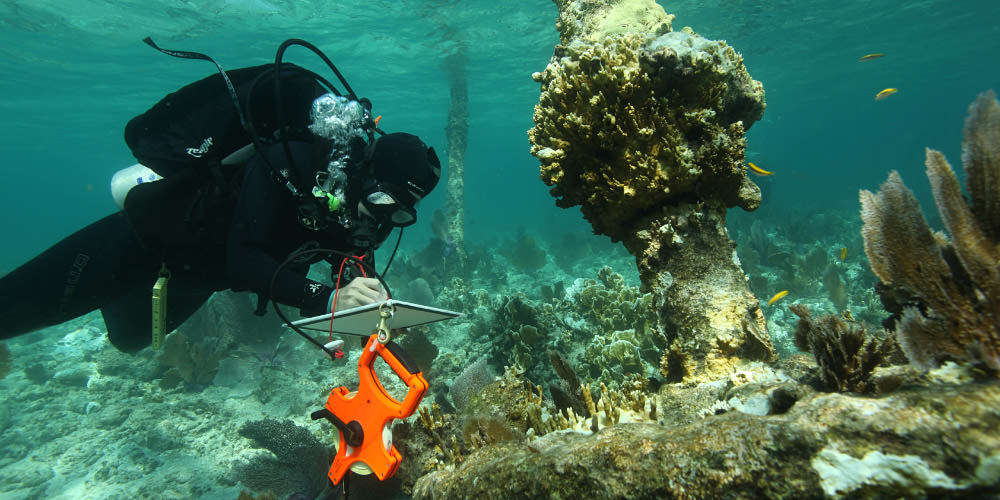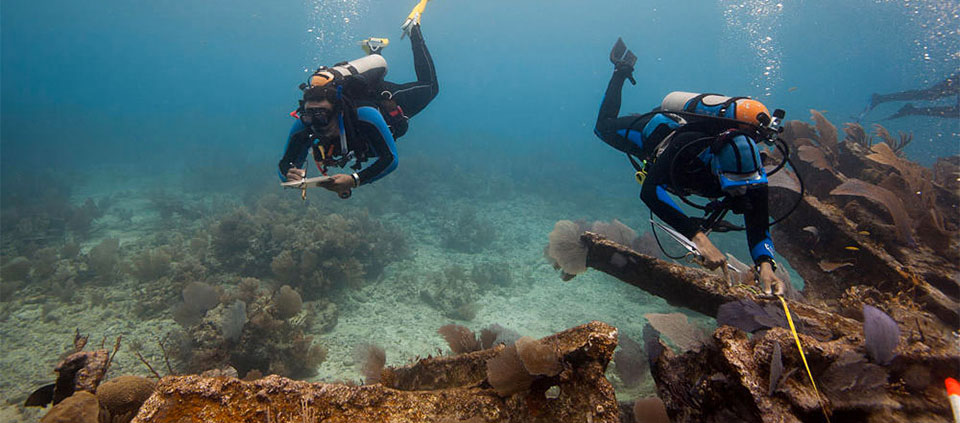Integrity of Heritage Resources
Florida Keys

Why is it a concern?
The Florida Keys' history is intimately linked to the biological diversity, location, and treacherous shallow water coral reefs that create significant navigational hazards. Indigenous peoples were known to have resided throughout the Florida peninsula and on the surrounding islands about 7,000 years ago surviving on the bountiful marine resources of the Florida Keys. The existence of indigenous people remained unchanged for approximately 4,000 years until the first European contact in 1513. European contact resulted in hundreds of years of exploration and the colonization of the new world.
The ocean has been the conduit of culture and history of the region with Key West at the crossroads of the Caribbean. An estimated 2,000 shipwrecks are thought to have occurred in the Florida Keys since European exploration of the Western Hemisphere. The importance of the sanctuary's maritime heritage resources is great and the possibility exists for discovering some of the earliest archaeological sites in North America. Archival research of shipwrecks in the Florida Keys so far has led to an approximate 669 accounts of losses. Field investigations performed after FKNMS designation resulted in over 400 physically recorded sites. Inventory activities continue today while priority sites are selected for full investigation. Currently, field projects on shipwrecks have resulted in 38 reports. There are a total of 14 shipwrecks and two lighthouses are listed in the National Register of Historic Places.
The Keys' dynamic shallow salt water environment, violent hurricanes, and treasure hunting have had a deteriorative effect on sanctuary's non-renewable resources. The Florida Keys have a long history of exploitation, and many pressures on sanctuary resources are chronic, and to some degree cumulative. Pressures on the resources include; treasure hunting and souvenir collecting, commercial and recreational fishing, disturbances to wildlife, coastal development, harmful algal blooms, marine debris, vessel groundings, the introduction of non-indigenous species, and vessel traffic. Human-driven factors such as climate change, sea level rise and ocean acidification are large-scale issues that may also affect sanctuary resources.
Proactive management of submerged archaeological resources in sanctuary waters is occurring in conjunction with the state of Florida and the Advisory Council on Historic Preservation. This partnership is responsible for managing cultural resources in the sanctuary consistent with the Federal Archaeology Program, the Abandoned Shipwreck Act of 1987 and the National Historic Preservation Act. Sanctuary regulations prohibit alteration of the seafloor, thus commercial salvage in the sanctuary must go through a review process before a permit for salvage is issued. A well-established law enforcement program is in place, including NOAA Fisheries Service, the Florida Fish and Wildlife Conservation Commission, and the U.S. Coast Guard.

Overview of Research
Research conducted by Sanctuary scientists and partners provides critical information to address existing and emerging resource conservation and management issues. The Overview of Research highlights some, but not necessarily all, of the research activities completed or ongoing at the Sanctuary.
| Project Name | PI and contacts | Links |
|---|---|---|
Mariner's Signposts: The U.S. Coast Survey's Florida Reef Beacons |
Matt Lawrence, SBNMS / Brenda Altmeier, FKNMS |
|
Hannah M. Bell Research Project |
Matt Lawrence, SBNMS / Brenda Altmeier, FKNMS |
Science Needs and Questions
The best available science is used by Sanctuary scientists and managers working to address priority resource conservation and management issues. As priorities change and new issues emerge, each Sanctuary develops new science needs and questions and works with partners to address them.
- What is the commercial value of a shipwreck site for heritage tourism?
- Does providing coordinates for maritime heritage sites increase pressure or appreciation?
- What are the best ways to connect shipwreck sites to provenance? Genealogy?
- How can we work with the diver certification agencies to incorporate cultural resource protection messages for new divers?
- How do we best organize FKNMS maritime heritage data?
- Would a web-based database for cultural resource monitoring engage divers to participate in photographing and recording information when they visit NMS sites?
- How do we create a relationship with the federal court?
- How long do historic materials last underwater?
Education and Outreach Material
Maritime Heritage Expeditions in ONMS
ONMS Maritime Heritage Program
Florida Underwater Archaeology Bibliography
Maritime Archaeological and Historical Society
Florida Division of Historical Resources
References
NMSP (National Marine Sanctuary Program). Florida Keys National Marine Sanctuary Condition Report 2011. U.S. Department of Commerce, National Oceanic and Atmospheric Administration, National Marine Sanctuary Program, Silver Spring, MD.
Office of National Marine Sanctuaries. 1997. Florida Keys National Marine Sanctuary Final Management Plan and Environmental Assessment. U.S. Department of Commerce, National Oceanic and Atmospheric Administration, Silver Spring, MD. Volume III, appendix I
Halas, Judith P. 1988. NOAA Technical Memorandum NA87AA-H-CZ007. An inventory of shipwrecks, groundings, and cultural marine resources within the Key Largo National Marine Sanctuary: A Preliminary Report. Submitted to the U.S. Department of Commerce, National Oceanic and Atmospheric Administration
Miller, James P. 2007. Atlas of Maritime Heritage Resources Florida Keys National Marine Sanctuary. Prepared for the National Oceanic and Atmospheric Administration, Florida Keys National Marine Sanctuary under order No. WC133C04SE1427.

